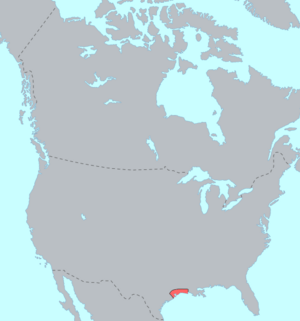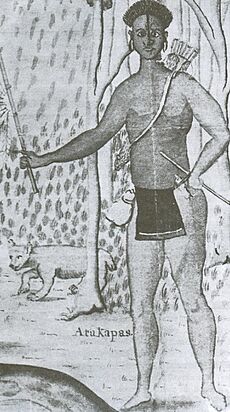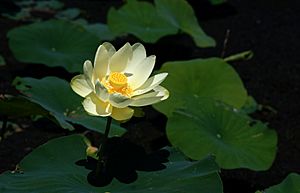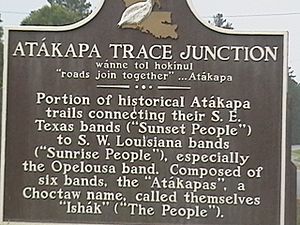Atakapa facts for kids
| Ishak | |
|---|---|
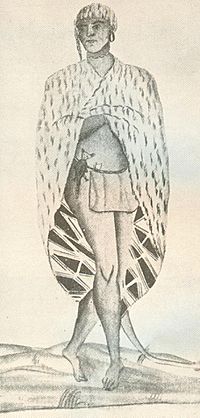
An Attakapas, by Alexandre De Batz, 1735
|
|
| Regions with significant populations | |
| United States (Louisiana, Texas) |
|
| Languages | |
| English, French, Spanish, Atakapa | |
| Religion | |
| Christianity, Indigenous religion | |
| Related ethnic groups | |
| isolate language group, intermarried with Caddo, Koasati, and Houma |
The Atakapa or Atacapa were a group of Native American people who lived along the Gulf of Mexico in what is now Texas and Louisiana. They included several distinct bands. They spoke a special language called Atakapa language, which was unique to their people.
After 1762, when Louisiana became part of Spain, less was written about the Atakapa. Many people died from illnesses in the late 1700s. Survivors often joined other nearby groups like the Caddo, Koasati, and Houma, but they kept some of their traditions. Some people with Atakapa heritage continued to live with their distinct culture into the early 1900s. Today, several groups identify as descendants of the Atakapa, though they are not officially recognized as tribes by the government.
Contents
The Atakapa People: A Look into Their History
Who Were the Atakapa?
The Atakapa called themselves the Ishak, which means "the people." Their name was also spelled in different ways, like Atacapaze or Attakapas.
Other groups, like the Choctaw, called them Atakapa. This name meant "eater of people." It was used because of certain ritual practices related to warfare. Europeans learned this name from the Choctaw and used it for the Atakapa. The Atakapa lived in river valleys, along lake shores, and coasts from present-day Vermilion Bay, Louisiana to Galveston Bay, Texas.
Their Unique Language
The Atakapa language was a unique language spoken only by the Atakapa people. It was once heard along the coasts of Louisiana and East Texas. Sadly, it is believed to have disappeared by the mid-1900s. Experts have studied the Atakapa language, but they don't fully agree on how it might be related to other languages.
A Glimpse into Atakapa History
Atakapa oral history says that their people came from the sea. An important leader from the past set out the rules for how they should live.
Early Encounters with Europeans
The first European contact with the Atakapa may have been in 1528. This was when survivors of a Spanish expedition, led by Pánfilo de Narváez, were blown ashore on the Gulf Coast. One group met the Karankawa, while another likely landed on Galveston Island. Among these survivors was Álvar Núñez Cabeza de Vaca, who later wrote about his years living among the Native Americans of the Texas coast.
In 1703, Jean-Baptiste Le Moyne, the French governor of Louisiana, sent explorers to the Gulf Coast. They met the Atakapa people. In 1714, the Atakapa were one of 14 tribes recorded as visiting Jean-Michel de Lepinay, who was the acting French governor.
A French explorer, Francois Simars de Bellisle, lived among the Atakapa from 1719 to 1721. He described their feasts and customs. Jesuit missionaries encouraged the Atakapa to stop certain practices.
A French historian, Antoine-Simon Le Page du Pratz, wrote about the Atakapa between 1718 and 1734. He mentioned that other groups called them "Man-Eaters" because of their custom of dealing with enemies. However, he also noted that after the French arrived, the Atakapa promised to stop these practices, and such acts were no longer heard of.
Life in the 18th Century
Louis LeClerc Milfort, a Frenchman, met the Atakapa in 1781. He found them hunting buffalo. He also met a European man named Joseph who had become their chief. Joseph explained that the name "Atakapas" (meaning "eaters of men") was given by the Spaniards. He said the Atakapa would deal with Spaniards fiercely to avenge their ancestors, but they did not eat them. Joseph also mentioned that the Atakapa welcomed English and French visitors kindly. He described their buffalo hunting methods and how they used buffalo for food and clothing. Joseph was happy living with the Atakapa and had a family there.
In 1760, a Frenchman named Gabriel Fuselier de la Claire bought land from an Eastern Atakapa chief named Kinemo. Soon after, a rival tribe, the Opelousa, attacked and defeated the Eastern Atakapa. The Opelousa were upset about the land sale.
A doctor named William Byrd Powell noted that the Atakapa had a unique custom of flattening the front of their skulls. This was different from other tribes, like the Natchez Nation, who flattened the back of their skulls.
The Atakapa traded with the Chitimacha tribe. In the early 1700s, some Atakapa married into the Houma tribe of Louisiana. Members of the Tunica-Biloxi tribe also joined the Atakapa tribe in the late 1700s.
Changes in the 19th and 20th Centuries
In 1805, only 175 Atakapa were recorded living in Louisiana. It is believed that most Western Atakapa groups were greatly reduced by the 1850s. This was mainly due to infectious diseases and poverty.
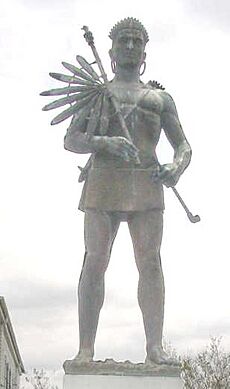
In 1908, nine known Atakapa descendants were identified. Armojean Reon (who lived from about 1873 to 1925) from Lake Charles, Louisiana, was noted as someone who spoke the Atakapa language fluently. In the 1920s, experts studied the language and published A Dictionary of the Atakapa Language in 1932.
Daily Life and Culture
The Atakapa ate shellfish and fish. Women gathered bird eggs, roots and seeds from plants like the American lotus (Nelumbo lutea), and other wild foods. Men hunted deer, bear, and bison. These animals provided meat, fat, and hides. Women also grew different kinds of corn. They prepared meats, bones, and skins for food storage, clothing, tent covers, tools, and other items they needed.
Men made tools for hunting and fishing, such as bows and arrows and fish spears with bone-tipped points. They used flint-tipped spears. They used special methods to catch fish, caught flounder by torchlight, and speared alligators in the eye. The people put alligator oil on their skin to repel mosquitoes. The Bidai band snared game and trapped animals in cane pens. By 1719, the Atakapa had obtained horses and hunted bison from horseback. They used dugout canoes to travel in the bayous and near the coast, but they did not go far into the ocean.
In the summer, families moved to the coast. In winters, they moved inland and lived in villages of houses made of poles and thatch. The Bidai band lived in bearskin tents. Important leaders and medicine men sometimes lived in homes built on earth mounds, which were created by earlier cultures like the Mississippian.
Atakapa Bands and Their Territories
Atakapa-speaking people are called Atakapan, while Atakapa refers to a specific tribe. Atakapa-speaking people were divided into different groups or bands. Each band often had a special animal symbol, called a totem, like a snake, alligator, or eagle.
Eastern Atakapa Bands
The Eastern Atakapa (Hiyekiti Ishak, "Sunrise People") groups lived in present-day Acadiana parishes in southwestern Louisiana. They included three main bands:
- The Ciwāt or Alligator Band lived near the Vermilion River and Vermilion Bay. The alligator was very important to them. They ate its meat, used its oil for cooking and to treat minor aches, and its scales for arrowheads.
- The Otse, Teche Band, or Snake Band lived in the prairies and coastal marshes around the Mermentau River and Bayou Teche. The snake symbolized the winding path of Bayou Teche.
- The Tsikip, Opelousa, or Heron Band were known for painting their lower legs and feet black during mourning ceremonies, like the long black legs of the heron. Before Europeans arrived, they lived between the Atchafalaya River and Sabine River. They were known for defending their territory.
Western Atakapa Bands
The Western Atakapa (Hikike Ishak, "Sunset People") groups lived in southeastern Texas. They were organized as follows:
- Atakapa (proper) groups, divided into major regional bands:
- The Katkoc or Eagle Band (also called the Calcasieu Band) lived along the Calcasieu River. They were named after the eagles in their area.
- The Red Bird Band lived in coastal areas of what is now Cameron Parish, in South Western Louisiana. Their symbol was the red bird.
- The Niāl or Panther Band lived near the Sabine River in South East Texas. Their totem was the panther.
- The Akokisa, Arkokisa, or Orcoquiza ("river people") lived along the lower Trinity and San Jacinto rivers and Galveston Bay in Texas. By 1805, some survivors lived on the lower Colorado and Neches rivers.
- The Bidai lived around Bedias Creek, ranging from the Brazos River to Neches River, Texas. Their name comes from a Caddo language word meaning "brushwood."
- The Deadose were a Bidai band that moved between the Brazos and Trinity rivers. They later settled near Spanish missions. Many Deadose people died from diseases like measles and smallpox. Survivors joined the Bidai, Akokisa, and Tonkawa peoples. They lost their distinct identity in the late 1700s.
- The Patiri lived north of the San Jacinto River valley in East Texas. Not much is known about them, but they might have been a southern Bidai band.
- The Tlacopsel are known from Spanish records of the 1700s. They lived in southeast Texas, possibly near the Bidai and Deadose.
Modern Atakapa Descendants
Today, several groups say they are descendants of the Atakapa. They have formed organizations and some have asked the governments of Louisiana, Texas, and the United States to officially recognize them as tribes. So far, these groups are not federally recognized or state-recognized Native American tribes. One group, the Atakapa Ishak Tribe of Southeast Texas and Southwest Louisiana, works to raise awareness about their heritage.
Atakapa Legacy Today
The names of present-day towns in the region can be traced to the Ishak people. These names come from their language and from French spellings of their leaders' names and places. For example, the town of Mermentau is a changed form of the local chief Nementou. "Plaquemine," as in Bayou Plaquemine Brûlée and Plaquemines Parish, comes from the Atakapa word pikamin, meaning 'persimmon'. Bayou Nezpiqué was named for an Atakapan who had a tattooed nose. The name Calcasieu comes from an Atakapa name, Katkōsh Yōk ('Crying Eagle').
The city of Lafayette, Louisiana, is planning a series of trails, funded by the Federal Highway Administration, to be called the "Atakapa–Ishak Trail." This will be a bike trail connecting downtown areas along the bayous Vermilion and Teche.
See also
 In Spanish: Atakapa (etnia) para niños
In Spanish: Atakapa (etnia) para niños
- USS Atakapa (ATF-149)
- Attakapas Parish


